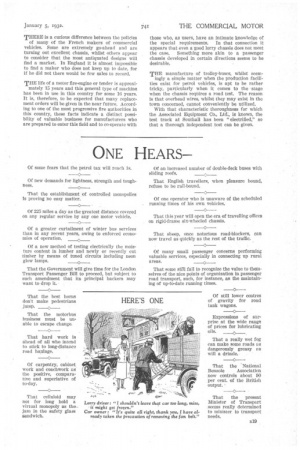A LARGE number of L - 1. manufacturers in America is adopting
Page 32

Page 33

If you've noticed an error in this article please click here to report it so we can fix it.
the free wheel as standard equipment, and there is a very much more marked interest in it in this country. During one of the recent dense fogs, an example of the utility of the free wheel was provided by a driver who was able to control his Millamequipped vehicle from the near side instead of from the off side, thus gaining much better vision of the kerb.
The method of procedure was to regulate speed, when it was necessary for the engine to propel the vehicle, by means of the hand throttle, and, when coasting, to provide a check, if needs be, by means of the centrally disposed hand-brake lever. So long as the vehicle could continue to move, the clutch was not required, as all changes were made with the free wheel.
To the uninitiated this procedure may sound somewhat risky, but to those who have proved its efficiency this advantage of the free wheel is really valuable.
AN amusing example of publicity carried to absurdity was to be found at the recent International Motor Show at Brussels. Over the restaurant was a poster some 50 ft. long and 20 ft. high, which advised each country to buy goods of its own manufacture. As 95 per cent of the exhibits were of foreign manufacture, those who showed them were justifiably indignant. B18 A, SHORT time ago somebody walked Into a small roadtravel hooking agency in a suburban district, purchased tickets and made definite seat reservations for journeys from London to Edinburgh, Edinburgh to Larbert, Larbert to Aberdeen, and Aberdeen to Elgin, the total distance being about 625 miles. It is remarkable that an intending traveller should be able to obtain tickets covering the whole journey, from a small sub-agency, the tickets showing not only the destinations, but the precise picking-up points, times of departure, etc. The main journey to Scotland was effected by the popular service of the Scottish Motor Traction Co., Ltd.
PARTICULARS regarding the development in the use of the combined harvester-thresher in this country have been given from time to time in The Commercial Motor. As the development involves the regular use of the motor lorry and the agrimotor the subject is of particular interest, especially in view-of the Government's policy to encourage home wheat production. This will inevitably lead to a more general use of,the machine, and no doubt the contractor will find scope for enterprise. One contractor appeared in the field last harvest. His machine was a small International; this cut and threshed over 170 acres on different farms, and would certainly have cut more had there been a drying plant available so that an earlier start could have been made after rain. THERE is a curious difference between the policies of many of the French makers of commercial vehicles. Some are extremely go-ahead and are turning out excellent chassis, whilst others appear to consider that the most antiquated designs will find a market. In England it is almost impossible to find a maker who does not keep up to date, for if he did not there would be few sales to record.
THE life of a motor fire-engine or tender is approxi mately 15 years and this general type of machine has been in use in this country for some 16 years. It is, therefore, to be expected that many replacement orders will be given in the near future. According to one of the most progressive fire authorities in this country, these facts indicate a distinct possibility of valuable business for manufacturers who are prepared to enter this field and to co-operate with those who, as users, have an intimate knowledge of the special requirements. In that connection it appears that even a good lorry chassis does not meet the case. Something more akin to a passenger chassis developed in certain directions seems to be desirable.
THE manufacture of trolley-buses, whilst seem ingly a simple matter when the production facilities exist for petrol vehicles, is apt to be rather tricky, particularly when it comes to the -stage when the chassis requires a road test. The reason is that overhead wires, whilst they may exist in the town concerned, cannot conveniently be utilized.
With that characteristic thoroughness for which the Associated Equipment Co., Ltd., is known, the test track at Southall has been "electrified," so that a thorough independent test can be given.




























































































